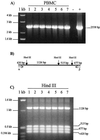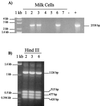Detection of bovine herpesvirus 4 (BoHV-4) DNA in the cell fraction of milk of dairy cattle with history of BoHV-4 infection
- PMID: 11101621
- PMCID: PMC87662
- DOI: 10.1128/JCM.38.12.4668-4671.2000
Detection of bovine herpesvirus 4 (BoHV-4) DNA in the cell fraction of milk of dairy cattle with history of BoHV-4 infection
Abstract
We have demonstrated, by PCR and restriction enzyme analysis of the PCR product, the presence of bovine herpesvirus 4 (BoHV-4) DNA in the cell fraction of milk from dairy cattle with a history of BoHV-4 infection. We next evaluated the infectious nature of BoHV-4 DNA in those cells. Cocultivation of a BoHV-4-sensitive cell line with BoHV-4 DNA-positive milk cell samples produced cytopathic effects. The same result was obtained from frozen and thawed milk cell fraction coming from the cell milk fraction PCR-positive cows, ensuring that cells were killed and only infectious virus could be recovered after cocultivation with sensitive cells. This report shows that infectious BoHV-4 can be present in milk cells and that therefore nursing may be one of the transmission routes of BoHV-4.
Figures


Similar articles
-
Detection of bovine herpesvirus type 4 antibodies and bovine lymphotropic herpesvirus in New Zealand dairy cows.N Z Vet J. 2014 Nov;62(6):351-5. doi: 10.1080/00480169.2014.933683. Epub 2014 Sep 29. N Z Vet J. 2014. PMID: 24967608
-
Rapid detection and differentiation of bovine herpesvirus 1 and 5 glycoprotein C gene in clinical specimens by multiplex-PCR.J Virol Methods. 2005 Sep;128(1-2):183-8. doi: 10.1016/j.jviromet.2005.05.001. J Virol Methods. 2005. PMID: 15939490
-
Detection of bovine herpesvirus 2 and bovine herpesvirus 4 DNA in trigeminal ganglia of naturally infected cattle by polymerase chain reaction.Vet Microbiol. 2014 Jun 25;171(1-2):182-8. doi: 10.1016/j.vetmic.2014.03.012. Epub 2014 Mar 25. Vet Microbiol. 2014. PMID: 24725448
-
Bovine Herpesvirus 1 Counteracts Immune Responses and Immune-Surveillance to Enhance Pathogenesis and Virus Transmission.Front Immunol. 2019 May 7;10:1008. doi: 10.3389/fimmu.2019.01008. eCollection 2019. Front Immunol. 2019. PMID: 31134079 Free PMC article. Review.
-
Biology of bovine herpesvirus 5.Vet J. 2010 May;184(2):138-45. doi: 10.1016/j.tvjl.2009.03.035. Epub 2009 May 5. Vet J. 2010. PMID: 19409823 Review.
Cited by
-
Whole Genome Sequencing of a Canadian Bovine Gammaherpesvirus 4 Strain and the Possible Link between the Viral Infection and Respiratory and Reproductive Clinical Manifestations in Dairy Cattle.Front Vet Sci. 2017 Jun 16;4:92. doi: 10.3389/fvets.2017.00092. eCollection 2017. Front Vet Sci. 2017. PMID: 28670580 Free PMC article.
-
Investigation of the susceptibility of human cell lines to bovine herpesvirus 4 infection: demonstration that human cells can support a nonpermissive persistent infection which protects them against tumor necrosis factor alpha-induced apoptosis.J Virol. 2004 Mar;78(5):2336-47. doi: 10.1128/jvi.78.5.2336-2347.2004. J Virol. 2004. PMID: 14963130 Free PMC article.
-
Whole Genome Sequence-Based Analysis of Bovine Gammaherpesvirus 4 Isolated from Bovine Abortions.Viruses. 2024 May 8;16(5):739. doi: 10.3390/v16050739. Viruses. 2024. PMID: 38793621 Free PMC article.
-
Serum and Milk Levels of Antibodies to Bovine Viral Diarrhoea Virus, Bovine Herpesvirus-1 and -4, and Circulation of Different Bovine Herpesvirus-4 Genotypes in Dairy Cattle with Clinical Mastitis.J Vet Res. 2023 Mar 16;67(1):33-40. doi: 10.2478/jvetres-2023-0010. eCollection 2023 Mar. J Vet Res. 2023. PMID: 37008768 Free PMC article.
-
Gene Expression Modulation in Bovine Endometrial Cells Infected with Gammaherpesvirus Type 4 and Exposed to Lipopolysaccharide in the Presence of Platelet-Rich Plasma.Viruses. 2025 May 23;17(6):744. doi: 10.3390/v17060744. Viruses. 2025. PMID: 40573335 Free PMC article.
References
-
- Bartha A, Juhasz M, Liebermann H. Isolation of a bovine herpesvirus from calves with respiratory disease and keratoconjuntivitis. Acta Vet Acad Sci Hung. 1966;16:357–358. - PubMed
-
- Bublot M, Lomonte P, Lequarre A S, Albrecht J C, Nicholas J, Fleckenstein B, Pastoret P P, Thiry E. Genetic relationships between bovine herpesvirus 4 and the gammaherpesviruses Epstein-Barr virus and herpesvirus saimiri. Virology. 1992;190:654–655. - PubMed
-
- Castrucci G, Frigeri F, Ferrari M, Ranucci S, Aldrovandi V, Cilli V, Rampichini L, Gatti R. Experimental infection of calves with strain of bovid herpesvirus-4. Comp Immunol Microbiol Inf Dis. 1987;10:41–49. - PubMed
-
- Cavirani S, Martelli P, Cabassi C S, Lavazza A, Allegri G, Flammini C F. Proceedings of the XIX World Buiatric Congress. 1996. Isolation of bovide herpesvirus 4 (BHV-4) from dairy cows with digital dermatitis; p. 121.
-
- Donofrio, G., S. Cavirani, C. S. Flammini, and F. Scatozza. Molecular typing of a BHV-4 (bovine herpesvirus 4) isolate. Vet. Res. Commun., in press. - PubMed
Publication types
MeSH terms
Substances
LinkOut - more resources
Full Text Sources

